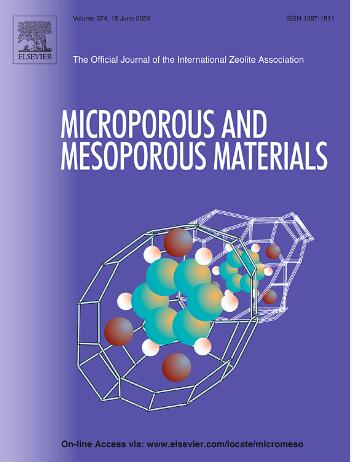Novel preparation of amorphous aluminosilicates via amorphous borosilicates by B-to-Al exchange
IF 4.8
3区 材料科学
Q1 CHEMISTRY, APPLIED
引用次数: 0
Abstract
The preparation of precursor amorphous materials for zeolite synthesis is one of important units, which has a significant impact on zeolite crystallization behavior. In this study, we propose a novel preparation method to obtain amorphous aluminosilicates used for zeolite synthesis. It consists of in the precipitation of amorphous borosilicates followed by B-to-Al exchange, which is inspired by post-synthesis treatment performed in zeolites. Amorphous borosilicates prepared under different conditions, aluminosilicates obtained by B-to-Al exchange, and CHA zeolites synthesized using the amorphous aluminosilicates were studied by various microstructural analyses, including UV-Raman spectroscopy, solid MAS NMR, and High-energy X-ray total scattering (HEXTS)/pair distribution function (PDF) analysis. The interesting finding is that Si/B ratios in the first mixture composition affect the subsequent progress of B-to-Al exchange and zeolite synthesis steps. In addition, the amorphous aluminosilicates prepared from amorphous borosilicates by B-to-Al exchange led to a wide synthesis window of CHA zeolite such as the reduction of the alkali concentration and the synthesis time. These results suggest that the novel amorphous aluminosilicates prepared from amorphous borosilicates by B-to-Al exchange could become a promising raw material for optimizing zeolite synthesis.

硼硅非晶交换制备非晶硅铝的新方法
前驱体非晶材料的制备是沸石合成的重要环节之一,对沸石的结晶行为有重要影响。在本研究中,我们提出了一种新的制备方法来获得用于沸石合成的无定形硅铝酸盐。它包括无定形硼硅酸盐的沉淀,然后是B-to-Al交换,这是受沸石合成后处理的启发。采用紫外拉曼光谱、固体MAS NMR、高能x射线全散射(HEXTS)/对分布函数(PDF)等多种显微结构分析方法,对不同条件下制备的非晶态硼硅酸盐、b - al交换得到的非晶态硅铝硅酸盐以及由非晶态硅铝硅酸盐合成的CHA沸石进行了研究。有趣的发现是,第一个混合物组成中的Si/B比例影响了B- al交换和沸石合成步骤的后续进展。此外,通过b - al交换法制备的无定形硼硅铝硅酸盐使CHA沸石的合成窗口变宽,如碱浓度降低、合成时间缩短等。这些结果表明,以硼硅为原料,通过b - al交换法制备的新型非晶态硅铝酸盐有望成为优化沸石合成的重要原料。
本文章由计算机程序翻译,如有差异,请以英文原文为准。
求助全文
约1分钟内获得全文
求助全文
来源期刊

Microporous and Mesoporous Materials
化学-材料科学:综合
CiteScore
10.70
自引率
5.80%
发文量
649
审稿时长
26 days
期刊介绍:
Microporous and Mesoporous Materials covers novel and significant aspects of porous solids classified as either microporous (pore size up to 2 nm) or mesoporous (pore size 2 to 50 nm). The porosity should have a specific impact on the material properties or application. Typical examples are zeolites and zeolite-like materials, pillared materials, clathrasils and clathrates, carbon molecular sieves, ordered mesoporous materials, organic/inorganic porous hybrid materials, or porous metal oxides. Both natural and synthetic porous materials are within the scope of the journal.
Topics which are particularly of interest include:
All aspects of natural microporous and mesoporous solids
The synthesis of crystalline or amorphous porous materials
The physico-chemical characterization of microporous and mesoporous solids, especially spectroscopic and microscopic
The modification of microporous and mesoporous solids, for example by ion exchange or solid-state reactions
All topics related to diffusion of mobile species in the pores of microporous and mesoporous materials
Adsorption (and other separation techniques) using microporous or mesoporous adsorbents
Catalysis by microporous and mesoporous materials
Host/guest interactions
Theoretical chemistry and modelling of host/guest interactions
All topics related to the application of microporous and mesoporous materials in industrial catalysis, separation technology, environmental protection, electrochemistry, membranes, sensors, optical devices, etc.
 求助内容:
求助内容: 应助结果提醒方式:
应助结果提醒方式:


